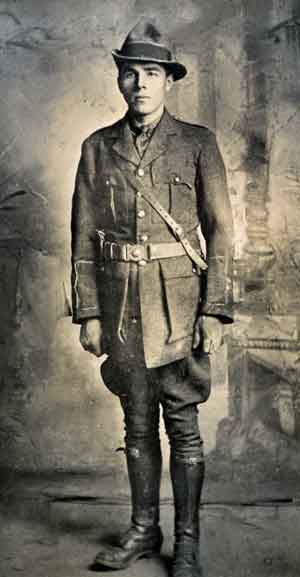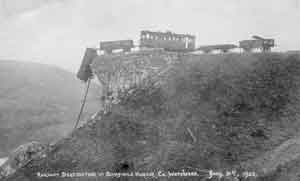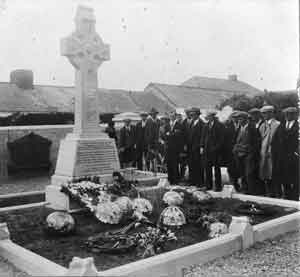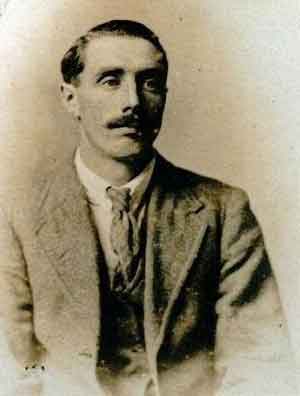THOMAS KEATING— A CIVIL WAR KILLING
Published in Features, Issue 2 (March/April 2023), Volume 31By David Prendergast

Above: Pat Keating—following his death at the Burgery ambush in March 1921, his brother Thomas (below) joined the IRA and took over his brother’s battalion in the Comeragh Mountains. (Waterford County Museum, John Quinlan)
The 10th of April 1923 brought a smattering of IRA leaders and foot-soldiers into the foothills of the Knockmealdowns. After the Executive was surprised and hunted by National Army troops of Gen. John T. Prout’s ‘big sweep’, a mortal blow was delivered to the anti-Treaty IRA—the fatal shooting of Liam Lynch. Following the news, Thomas Keating, commandant of the IRA’s Waterford 2nd Battalion, retreated from the Knockmealdowns back into his home county.
Although the shooting of Lynch was a checkmate moment for the National Army, the killing was far from done. The Knockmealdown and Comeragh Mountains were swarming with up to 1,000 National Army soldiers, rolling in a pincer fashion to trap and eliminate the last remnants of enemy stragglers. In fact, less than 24 hours after the death of Lynch, Keating would be shot dead in one of the darkest and most controversial moments of the Civil War in the Deise county.
KEATING’S CIVIL WAR JOURNEY
Like all his IRA comrades in April 1923, Keating was war-weary after a brutal winter. Public sympathy had receded, food became harder to source and home was more and more challenging to visit. Most nights were spent out in the open, with nothing but disused cattle-feed sacks as blankets.
Not twelve months before, Keating had enjoyed a heavily fortified position at the old Famine workhouse in Kilmacthomas. The site consisted of a dining hall, a chapel, a two-storey hospital, a three-storey dormitory, and two single-storey buildings at the site entrance. It had been designed to house up to 600 people, and thus it was an excellent military position to command. He managed to hold it until late August, when he finally abandoned it owing to mounting pressure coming east from Waterford city and west from Dungarvan. Despite orders from GHQ to burn all abandoned headquarters, Keating left the workhouse intact following pleas from the local priest and convent. This was a sign of his moral character before the heavy days of the conflict. In just a few short months, he would threaten to burn down a local dancehall and become a suspect in the burning of Protestant ‘big houses’, Comeragh House and Rockmount House (the former destroying all personal papers of the explorer John Palliser’s expedition that mapped western Canada for the British government in 1857–60).
THE GUERRILLA PHASE
Following his withdrawal from the Kilmacthomas workhouse, Keating took to the nearby Comeragh Mountains. He had lived and worked there as a farmer until his younger brother Pat’s death in the War of Independence dragged him into the armed struggle for a republic. Here Keating waged an unsuccessful guerrilla campaign against the National Army. Intelligence reports dated 6 October 1922 would note that his column had been all but destroyed owing to mass arrests.

Above: Thomas Keating made a habit of attacking railways throughout the winter of 1922–3. Here a train dangles over the blown viaduct at Ballyvoile, Co. Waterford. (Waterford County Museum)
Keating was nearly killed in late October when he was recognised after dark on the streets of Kilmacthomas, but the National Army soldier’s rifle jammed six times during the resultant chase. Though increasingly isolated, Keating and his remaining men turned their attention to a hybrid war of propaganda and critical infrastructure attacks. December 1922 was a particularly busy month for Keating, which saw trains derailed and burned at Durrow (twice), Ballyvoile and Kilmeadon, in addition to the felling of trees and the mining of roads. Safely harboured in the Comeraghs, Keating’s knowledge of the mountains from his years as a sheep farmer made him a challenging foe to anticipate and apprehend.
PUTTING THE WAR BEHIND HIM
Nevertheless, on 10 April, following the confirmation of Lynch’s death, Keating informed his brigade commander, Michael Mansfield, that his war was over. He was returning home to the parish of Kilrossanty to keep alive Republican values by other means. Crossing the mountains the following morning after an overnight stay at a safe house in the Nire Valley, Keating came to within 90 minutes of his home on foot.
Then, despite being within touching distance of home, he unexpectedly strayed from his course, veering instead towards the townland of Coolnasmear, a small village outside Dungarvan, where he would meet his doom. In their testimony at Keating’s medical inquest, the National Army would assert that a party of four soldiers surprised Keating in a safe house in Coolnasmear at around 2.30pm as they continued Prout’s sweep of the mountains.
They would testify that Keating was ordered to surrender, refused and opened fire on them while attempting to escape. After they lost him as he descended light-footed down a rocky gully, a second party of soldiers patrolling nearby flanked him and shot him through his side at a reported distance of 880 yards.
The Keating family, however, has another story. This goes that Keating was set up and lured to Coolnasmear. National Army snipers were waiting for him to enter a clearing known as the wooded path. There he was immediately shot on sight in cold blood upon coming into view.
Regardless of whichever version one chooses to believe, the next part of Keating’s story—the final hours of his life—is sadly indisputable. Despite the National Army soldiers’ testimony at the medical inquest that they did everything medically possible for the wounded man, this was not the case.
EXTREME MEDICAL NEGLIGENCE

Above: The Republican Plot in Kilrossanty churchyard, Co. Waterford, where Thomas Keating lies alongside his younger brother Pat. (Waterford County Museum)
The bullet that struck Keating entered the left side of his torso, hit his right hip bone and ricocheted through the front of his abdomen, tearing his intestines in three places in the process. The National Army brought him to a nearby farmhouse, where the local parish priest, Fr Michael Burke, bandaged the badly injured man.
Rather than immediately delivering Keating to a hospital, the soldiers left him in the back of their Crossley tender as they proceeded on a celebratory pub-crawl across west Waterford. Finally, as the group entered Cappoquin later that evening, Keating, still bleeding profusely from his gut wound, was tied up in a standing position in the military vehicle as they paraded into town. Having been shot at approximately 2.30pm that day, it was almost six hours before Keating was eventually examined by a medical doctor. An ambulance was finally sequestered, and Keating was brought to Dungarvan hospital shortly before midnight. He would die undergoing surgery a few hours later on 12 April.
A WELL-KNOWN NAME
Owing to his reputation, Keating was a high-profile killing for the National Army. Throughout the War of Independence the Keating residence, nestled in the Comeraghs, was a safe house for members of the IRA’s West Waterford flying column. Keating’s four sisters all worked as dispatch-carriers. His father, who had been jailed as a youth during the Land War, manned the many arms dumps located near their land in the derelict cottages resulting from the several evictions that had taken place in the area. Following Waterford’s most successful IRA ambush at Piltown Cross in November 1921, captured British arms were transported to the Keating home before being ferried to the various hiding places in the Comeraghs.
It was Keating’s younger brother Pat, however, who was the trump card in the Keating family deck. He had been a legendary figure to the point that the Black and Tans had promised a reward of £1,000 for his capture alive. This led to Pat using the disastrous Pickardstown ambush in January 1921 as an opportunity to fake his own death. The Black and Tans, searching for proof of his body, went as far as to disinter the body of a Keating relative who had recently been buried. As a result of this, following Pat’s actual death in March 1921 he was buried on three separate occasions across two months to keep his body out of British hands. Thus the Keating name carried great weight in Waterford IRA circles.
SECOND-HAND TESTIMONY
It is well known that the National Army testimony regarding Keating’s care in their custody was false. This discrepancy inevitably casts doubt on their remaining testimony. There is, at a minimum, one lie told by the soldiers—that Keating got immediate access to medical treatment.
How many others did they tell? Was Keating given the opportunity to surrender? Was Keating armed? Did he begin the fire fight? Sadly, the only primary documentary evidence of the gun battle that led to his death consists of newspaper accounts of his medical inquest. No detailed information can be gleaned from army reports, pension applications or military witness statements. Nevertheless, the newspaper accounts do highlight one glaring omission: none of the testimony offered by the National Army came from a member of the group that witnessed Keating’s shooting or immediate capture. Of the two National Army soldiers to testify, one was from the first group that initially found Keating but lost track of him in the subsequent chase, and the other was from a third group that happened upon the scene in Coolnasmear after Keating had been shot and captured. Thus their testimony concerning Keating’s actual shooting and capture was only second-hand information.
THE MISSING MEDICAL REPORT
Keating’s nephew says that his uncle’s siblings requested a copy of the coroner’s report multiple times, and even tried to have another inquest opened for their brother, but all to no avail. They never received a copy of the report, leading the family to believe that it had been destroyed. A search of the Military Archives in Cathal Brugha Barracks and the National Archives in Dublin proved fruitless. An inquiry to the Waterford County Council archivist confirmed that these documents remain unlocated. The archivist advised that she had previously searched the courthouse archives of Waterford, Lismore, Dungarvan and Youghal. She has also contacted previous coroners, but all to no avail.
Lastly, the Keating family could never understand and come to terms with why he had come so close to home on the morning of 11 April only to veer from his course and head toward Coolnasmear. As an experienced mountain man, his trajectory that day made no sense to them and thus they became concerned that he had in fact been betrayed and sold out to the National Army. That he was in the company of an anti-Treaty dispatch-carrier just before arriving in Coolnasmear certainly contributes to the theory that he was lured to the area. Moreover, his subsequent treatment after his shooting and capture would certainly hint at an over-joyous group of soldiers who had been eager to get their hands on such a high-profile anti-Treatyite.
Unfortunately, Keating’s story has been muted owing to the taboo nature of the Civil War and the bitterness that remained in Irish society following the conflict’s conclusion. Instead, his contribution to Ireland’s fight for freedom has been reduced to a footnote. This contrasts sharply with his brother Pat’s role in the War of Independence. While the Bureau of Military History’s witness statements and pension files are excellent resources to help craft a complete picture of Pat’s heroics during the revolutionary period, for Thomas Keating, whose main armed action took place in the Civil War, snippets are nearly absent.
David Prendergast has a BA in English and History from the University of Limerick and an MA in Journalism and Media Communications from Griffith College Cork.
Further reading
T. Mooney, A Deise divided (Kilkenny, 2021).
S. & S. Murphy, The Comeraghs: gunfire and civil war (Waterford, 2020).
D. Prendergast, ‘The life and death of Thomas Keating’, Decies 78 (2022).

















